Hadronization/Underlying Event Systematic for 2005+2006 jet aLL Part I
The Hadronization and Underlying Event Systematic aims to estimate the change in jet pT scale due to the underlying event (UE) and out-of-cone (OOC) fragmentation. In the 2005 PRL, and the current 2005+2006 paper, the jet asymmetry pT is corrected to the particle jet level. However, these asymmetry measurements are compared to NLO QCD calculations, where the scattered parton has not fragmented and UE effects are not included. This systematic is designed to estimate the difference between the particle jet scale we experimentally correct back to and the NLO scale calculated by the theorists. This systematic was first estimated in 2005 and is documented in the attached BLOjet.ppt document.
Review
Ideally, to compare with NLO theory, we need an NLO MC generator. We do not have one. Instead PYTHIA is a LO generator with initial and final radiation included. As a result there is some ambiguity as to what level in the parton shower evolution it is ideal to correct the jet energy scale back to. Whatever level, the traditional method consists of comparing the particle jet pT (jets composed of stable final state particles) with the associated jet pT at the desired level and finding an average correction as a function of the particle level jet pT. Here are the possible options:
1. PARTON level
This is the pT of the parton which participated in the hard interaction and is most closely associated with the particle jet.
Corrections to this level would be systematic underestimates due to the lack of gluon radiation outside of the cone.
2. Beyond Leading Order (BLO) with UE off
This is the pT of the fragmented partons as determined by applying the same jet algorithm used to define particle jets. The underlying event is turned off.
Corrections to this level would be systematic overestimates due to loss of fragmented partons outside of the code
3. Beyond Leading Order (BLO) with UE on
This is the pT of the fragmented partons as determined by applying the same jet algorithm used to define particle jets. The underlying event is turned on.
Corrections to this level contain systematic overestimates (due to OOC) and underestimates (due to UE).
NOTE: All of these options are with the initial and final radiation switch turned on in PYTHIA. This matches most closely with NLO calculations which also allow for gluon radiation.
I believe option 2 is the one we really want. It determines the pT scale with the correct jet algorithm, includes initial and final radiation just as NLO does, and removes contributions from the underlying event. The problem is that due to the construction of the PYTHIA algorithm it is impossible to associate particle jets with UE turned on with BLOjets with UE turned off. The reason is that the same seed will lead to different events and therefore the association is lost. That means the closest level we can apply this correction to is 1 or 3.
One option I would like to discuss is a correction to level 2 by simply looking at the pT shift of the inclusive spectrum for BLO jets with UE off and particle jets. We would not be able to use association but my guess is that the shift would be fairly constant (slopes are the same).
We could correct back to the parton pT level. I have always argued against this option because my understanding is that jets are only well defined by their algorithm. Correcting back to the parton level does not incorporate any jet algorithm (no split/merge or seed etc) and it underestimates the correction (we never lose a gluon from the cone) and in the end is really just a correction back to LO. However there is good precedent for this type of correction a la CDF.
This systematic needs to be re-evaluated for the 2006 data due to the change in jet radius from R=0.4 to R=0.7. Mike Miller created the original package which combined the existing jetfinder with new code allowing it to run over fragmentation partons in addition to stable final particles. The original code ran on MAC_OS box at MIT. I have now ported this code over to rcf and incorporated it into the STAR framework. It lives at ~rfatemi/gen-2.0 and is currently run using the macros in that directory. The ultimate goal is to find an appropriate place for this within the existing STAR CVS jet framework.
Procedure:
1) Create 250K event samples with partonic pT: 3-5, 5-10, 10-20, 20-40, 40-60
2) Run jetfinder algo over fragmented parton jets and stable particle jets (for example see PythiaRecordExample.pdf)
3) Output all BLOjets and Particle jets with pT > 5, R=0.4 and R=0.7
4) Place appropriate jet Eta cut and perform association of dR < 0.2/0.4 for 2005/2006 respectively.
Consistency Checks (Figures 1-8):
Figure 1:
Sanity Check #1 - check that the histogram of the partonic pT for each sample normalized to the relevant factors connects smoothly. The LHS/RHS are for R=0.4/0.7 corresponding to 2005 and 2006 respectively.


Figure 2a:
Sanity Check #2 - If Mikes ported code is performing correctly then the particle jets I get out of the stand-alone PYTHIA code should be the same as the particle jets I get from running the CVS STAR standard jetfinder over the full PYTHIA+GEANT simulations. The plot on the right shows each set of particle jets for R=0.4 and 0.2 <Jet Eta < 0.8. The ratio of the two is unity out to pT=40 GeV. I attribute the discrepancy after 40 GeV to the different partonic pT distributions for each sample (stand alone has pT=40-60 while full simulation has 45-55 + 55-65). The left side plot compares NLO to particle jets from the full STAR simulation.
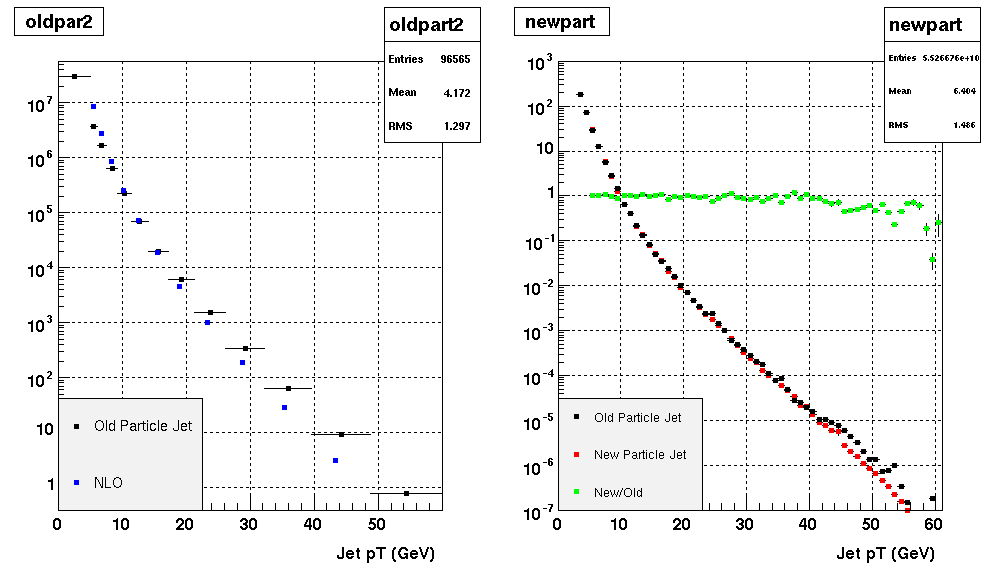
Figure 2b:
As an additional sanity check I coped over the values of the particle jets for radius=0.4, 0.2<eta<0.8 particle jets from the original code used for the 2005 PRL and compare them in the plot below to the current particle jets calculated with the new code that has been ported to RCF. The agreement is very good for all subprocesses. The move to RCF seems to have preserved the consistency with the old code and the current jetfinding code. Yea!

Figure 3:
These plots compare Particle and BLO jets for a radius of 0.4 and 0.7 versus of pT. For the sake of comparison, both sets of jets (R=0.4 and R=0.7) are restricted to 0.2 < Jet Eta < 0.8 and use association dR < 0.2. The top left is all subprocesses together, top right for qq subprocess, bottom left for qg and bottom right for gg subprocess. The major physics conclusions are stated for the ratio plots below (Figures 4-7).

Figure 4:
Particle/BLO Yield versus jet pT for R=0.4. Shows that the particle jet pT spectrum is systematically shifted downward for all pT. This shift is subprocess dependent with quarks being ~0.8 and gluons at ~0.5. This supports the fact that hadronization results in substantial OOC effects, with these effects begin larger for gluons than quarks.
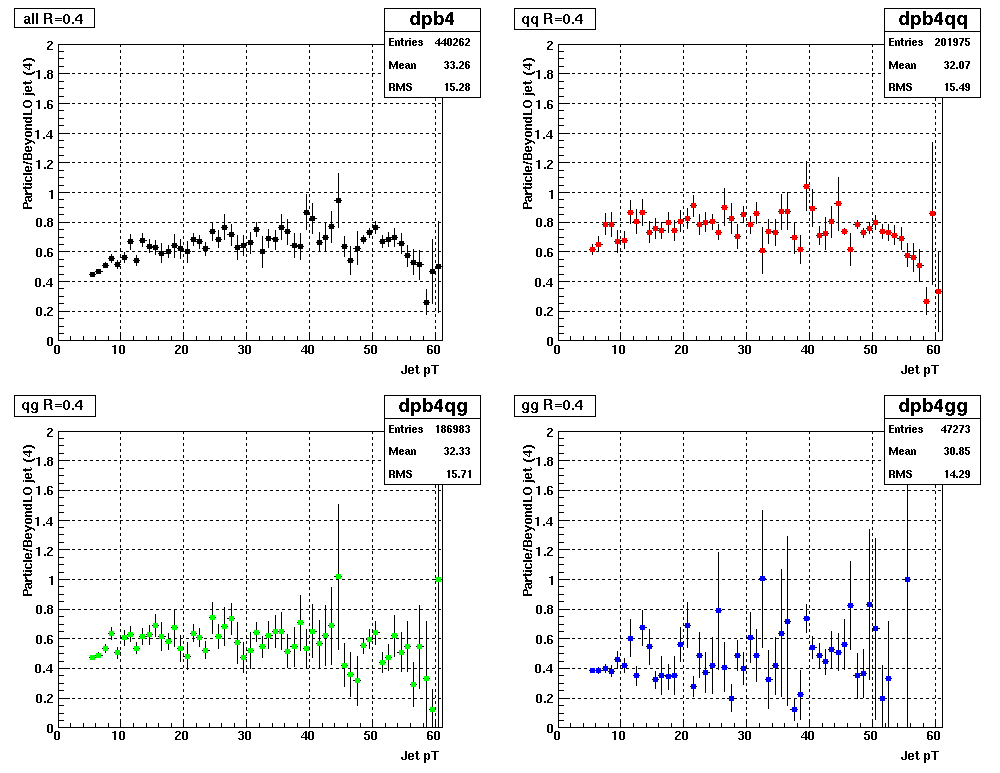
Figure 5:
Particle/BLO Yield versus jet pT for R=0.7. Shows that the particle jet pT spectrum is systematically shifted downward for all pT. This shift, like the R=0.4 sample, is subprocess dependent with quarks being ~0.9 and gluons at ~0.6. As expected this shift is smaller than for the R=0.4 sample.
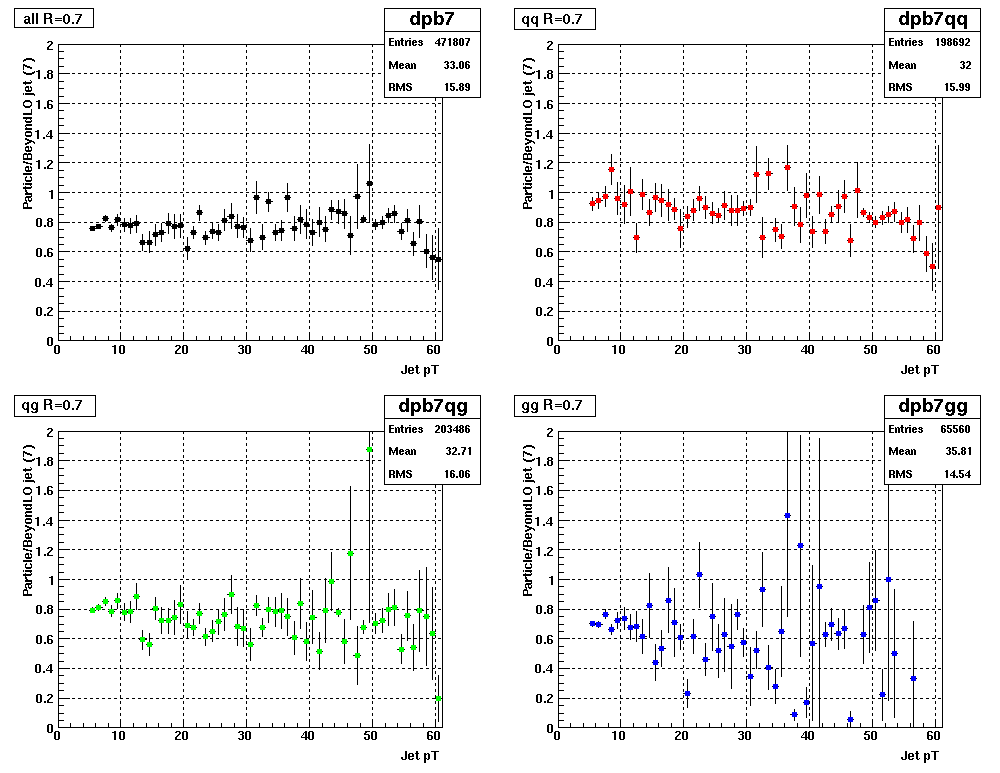
Figure 6:
The ratio of particle jet yields for radius =0.4/0.7 is subprocess dependent, with an average of 0.6 for quark jets and 0.3 for gluon jets. This again supports the idea that gluon jets are much more affected by hadronization effects. A similar plot was made for the NLO calculation at pT=15 by Stephen T. - documented at http://www.star.bnl.gov/protected/spin/trent/jets/2005/nov10/Rscale_unp_ratio.gif. The ratio of R=0.4/0.7 from the NLO is ~ 0.55 at pT=15 GeV which agrees fairly well with the ratio of particle jets in the top left panel below (~0.5). Note Stephen's plot is for 0.8<eta<0.8, while this plot is for 0.2<eta<0.8.

Figure 7:
Ratio of BLOjet spectra for R=0.4/0.7. The ratio is subprocess dependent with the quark/gluon ratio ~0.7/0.4. This points to significant OOC effects going from the parton to the BLO level. These effects cannot be included in our current systematic.

Analysis
Figure 8:
The average pT shift for R =0.4 associated particle and BLOjets (with UE and radiation turned on). The particle jets are required to have 0.2< jetEta <0.8 and BLOjets are associated to a level of dR < 0.2. The p1 (slope) fit values are slightly but systematically larger than those estimated for the 2005 PRL (see BLOjet.ppt). This difference is not understood and is the only unexplained effect (old p1 = 1.026/0.995/1.049/1.06 vs new p1 = 1.063/1.028/1.075/1.144). The only known difference is the PYTHIA version used.

Figure 9:
The average pT shift for R =0.7 associated particle and BLOjets (with UE and radiation turned on). As expected the shift from particle to BLO is smaller for R=0.7 compared to R=0.4. These values are only for 0.2< jetEta <0.8 and dR < 0.2 in order to facilitate direct comparison with the R=0.4 2005 sample.
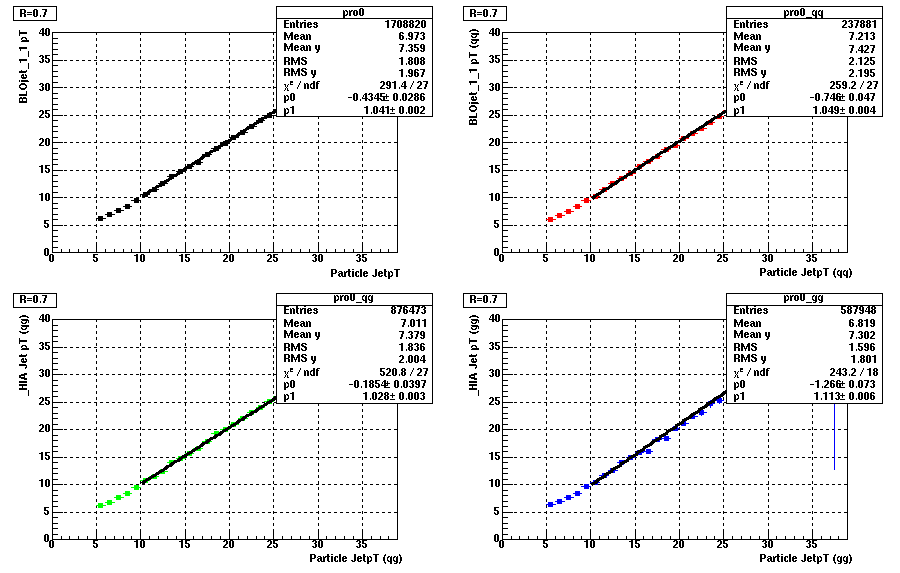
Figure 10:
Same as figure 9 but with the condition that -0.7 < jetEta < 0.9. The effect is reduced but gluon jets are still more affected than quark jets.
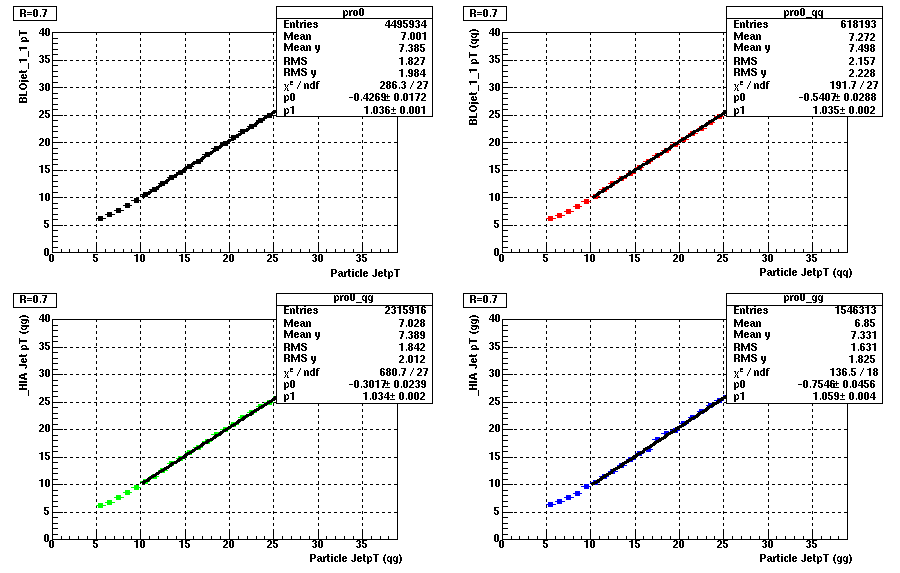
Figure 11:
Again Particle jet versus Blojet (UE on). The particle jet -0.7 < eta <0.9 but the dR < 0.4 this time. The correction is larger in this case and surprisingly
bigger for quark jets.

Figure 12:
Particle jets versus Parton jets for R=0.7, particle jet eta -0.7 < jetEta < 0.9, parton association dR< 0.2.

Figure 13:
Same as Figure 12 but with parton association dR < 0.4.
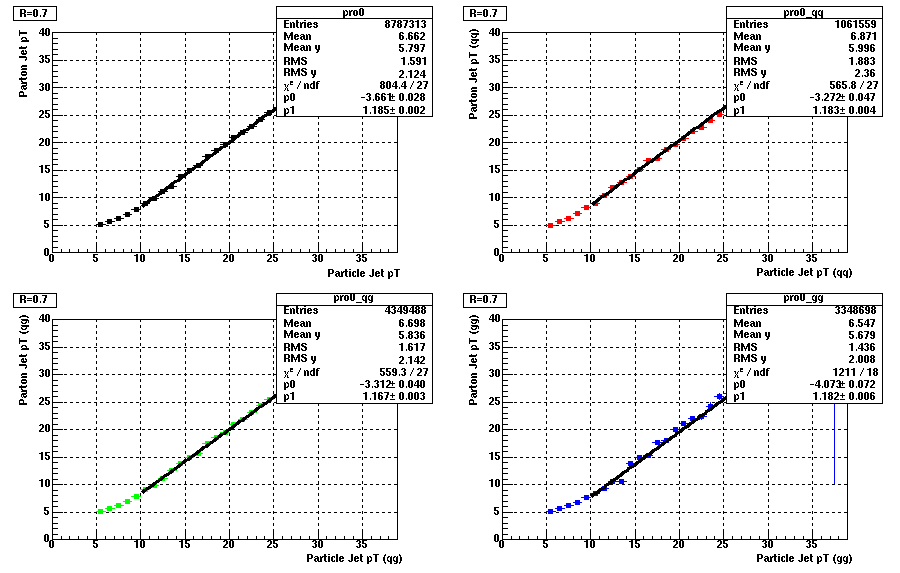
Conclusions:
1. The Hadronization/UE code has been ported to RCF and appears to be working correctly.
2. One exception is the pT shift determined by particle and BLOjet association for the R=0.4 jets. The current shift is larger than previously determined.
3. There are significant, subprocess dependent, hadronization effects which reduce the energy in the cone. These effects are larger for gluons than quarks and larger for smaller radius jets.
4. There are 3 options for this correction/systematic and we need to decide which ones to pursue (perhaps all?)
- Use association of particle and BLOjets (UE ON) to determine average pT shift
- Use inclusive spectrums of particle and BLOjets (UE OFF) to determine average pT shift
- Use association of particle and parton jets to determine average pT shift
5. Size of correction can double with change in dR cut.
- rfatemi's blog
- Login or register to post comments
